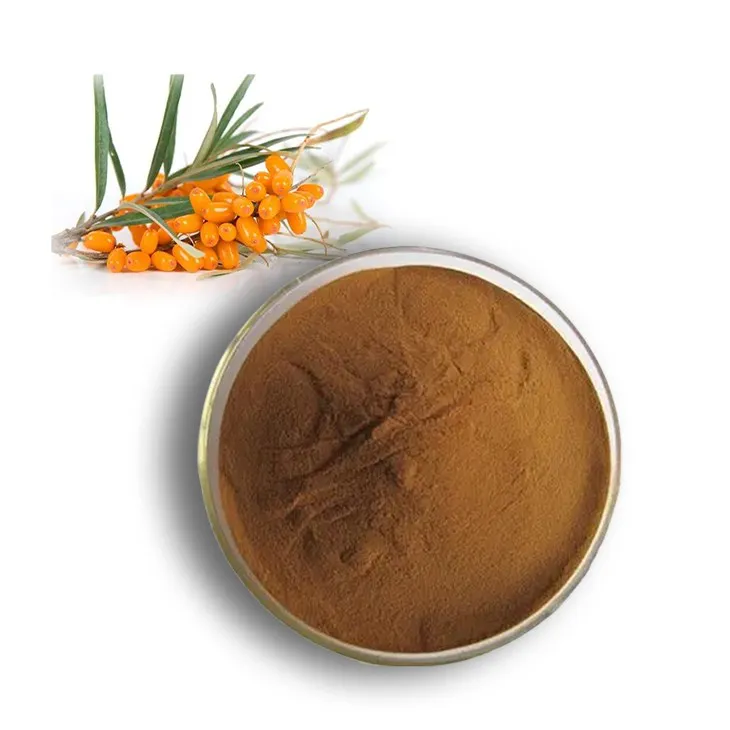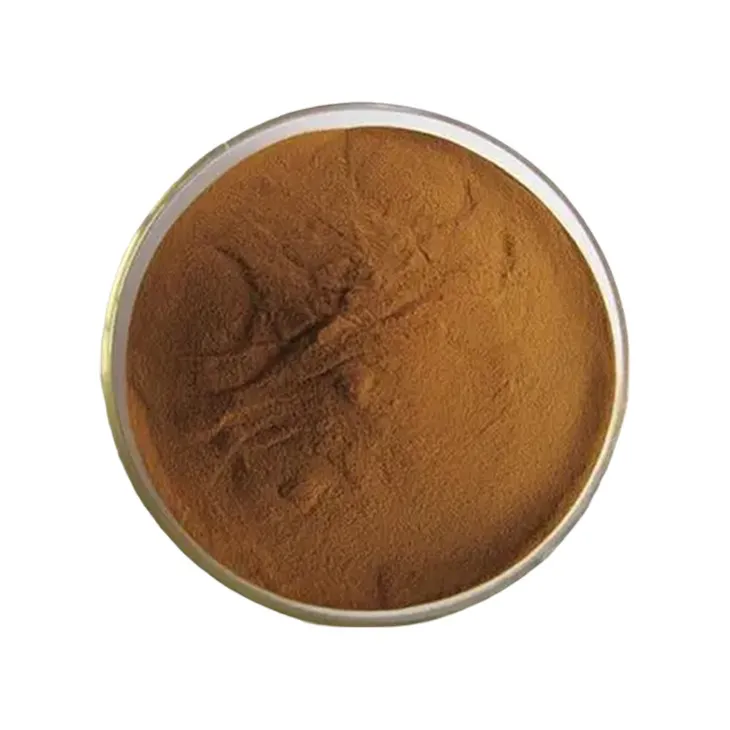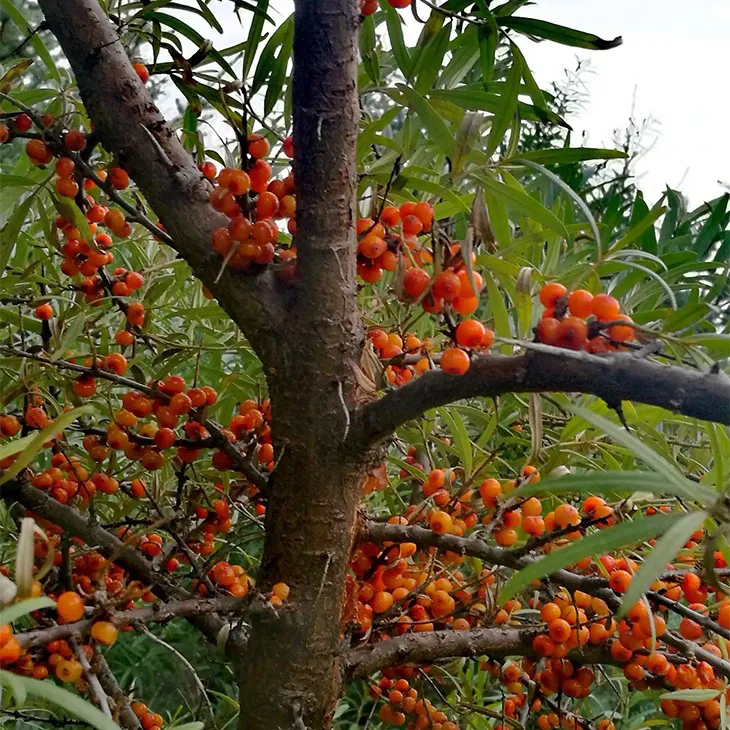- 0086-571-85302990
- sales@greenskybio.com
Optimal Bioavailability of Sea - Buckthorn Bark Extract.
2024-11-26

1. Introduction
Sea - buckthorn (Hippophae rhamnoides) has been recognized for its numerous health - promoting properties. The bark extract of sea - buckthorn is particularly rich in bioactive compounds such as flavonoids, phenolic acids, and tannins. These compounds have shown antioxidant, anti - inflammatory, and anti - microbial activities. However, the full potential of sea - Buckthorn bark extract can only be realized when its bioavailability is optimized. Bioavailability refers to the proportion of a drug or a nutrient that enters the systemic circulation and is available at the site of action. In the case of sea - Buckthorn bark extract, several factors can influence its bioavailability, including environmental factors, processing conditions, and individual physiological differences.

2. Properties of Sea - Buckthorn bark extract
2.1 Chemical Composition
The chemical composition of sea - buckthorn bark extract is complex. Flavonoids are one of the major components, which include Quercetin, kaempferol, and isorhamnetin. These flavonoids contribute to the antioxidant activity of the extract. Phenolic acids such as caffeic acid and ferulic acid are also present. Tannins, which are polyphenolic compounds, are another important part of the extract. They play a role in the anti - microbial and anti - inflammatory activities.
2.2 Biological ActivitiesThe sea - buckthorn bark extract has been shown to possess antioxidant activity. This is mainly due to the presence of flavonoids and phenolic acids, which can scavenge free radicals and prevent oxidative damage to cells. Anti - inflammatory activity has also been reported. The extract can inhibit the production of inflammatory mediators such as cytokines. In addition, the anti - microbial activity of the extract makes it a potential candidate for the development of new antimicrobial agents. It can inhibit the growth of bacteria, fungi, and viruses.

3. Factors Affecting Bioavailability
3.1 Environmental Factors
3.1.1 Geographical Origin
The geographical origin of sea - buckthorn can have an impact on the bioavailability of its bark extract. Sea - buckthorn plants grown in different regions may have different soil compositions, climatic conditions, and levels of sunlight exposure. These environmental factors can influence the chemical composition of the bark extract. For example, plants grown in regions with high soil fertility may produce bark extract with higher levels of bioactive compounds, which may potentially lead to better bioavailability.
3.1.2 Harvesting TimeThe harvesting time of sea - buckthorn bark is also crucial. Different harvesting times can result in variations in the content of bioactive compounds in the bark. If the bark is harvested at the wrong time, the levels of flavonoids, phenolic acids, and tannins may be sub - optimal, thereby affecting the bioavailability of the extract.
3.2 Processing Conditions3.2.1 Extraction Methods
Different extraction methods can lead to different yields and qualities of sea - buckthorn bark extract. Solvent extraction is commonly used, but the choice of solvent can influence the extraction efficiency and the composition of the extract. For example, polar solvents may be more effective in extracting polar compounds such as phenolic acids, while non - polar solvents may be better for extracting non - polar flavonoids. The extraction time and temperature also play important roles. High extraction temperatures for a long time may cause degradation of some bioactive compounds, reducing the bioavailability of the extract.
3.2.2 Formulation and EncapsulationFormulation and encapsulation are important steps in improving the bioavailability of sea - buckthorn bark extract. Formulations can be designed to enhance the solubility and stability of the extract. Encapsulation can protect the extract from degradation in the gastrointestinal tract and improve its controlled release. Different encapsulation materials such as lipids and polymers can be used, and the choice depends on the properties of the extract and the desired release profile.
3.3 Individual Physiological Differences3.3.1 Digestive System
Individual differences in the digestive system can affect the bioavailability of sea - buckthorn bark extract. Factors such as gastric emptying time, intestinal transit time, and the activity of digestive enzymes can vary from person to person. For example, people with slow gastric emptying may have a longer time for the extract to be absorbed, which may lead to differences in bioavailability. The activity of intestinal transporters also plays a role. Some bioactive compounds in the extract may require specific transporters for absorption, and individual differences in the expression and function of these transporters can influence the bioavailability.
3.3.2 Metabolic EnzymesMetabolic enzymes in the body can metabolize the bioactive compounds in sea - buckthorn bark extract. Cytochrome P450 enzymes are involved in the metabolism of many drugs and natural products. Individual differences in the activity and expression of these enzymes can result in different rates of metabolism of the extract's components. This can lead to variations in the bioavailability of the active compounds, as some metabolites may have different bioactivities compared to the parent compounds.

4. Strategies to Improve Bioavailability
4.1 Combination with Other Substances
4.1.1 Co - administration with Vitamins
Combining sea - buckthorn bark extract with vitamins can potentially improve its bioavailability. For example, vitamin C is a well - known antioxidant that can enhance the antioxidant activity of the extract. It may also protect the bioactive compounds in the extract from oxidation during absorption. Vitamin E can also play a role in improving the stability and bioavailability of the extract by protecting the lipid - soluble components.
4.1.2 Use of ProbioticsProbiotics can interact with sea - buckthorn bark extract in the gut. They can improve the gut microbiota environment, which may enhance the absorption of the extract. Probiotics can also modulate the activity of digestive enzymes and intestinal transporters, thereby influencing the bioavailability of the extract.
4.2 Novel Delivery Mechanisms4.2.1 Nanoparticle - based Delivery
Nanoparticle - based delivery systems offer several advantages for improving the bioavailability of sea - buckthorn bark extract. Nanoparticles can increase the solubility of the extract, protect it from degradation, and enhance its cellular uptake. For example, lipid - based nanoparticles can encapsulate the extract and target specific cells or tissues in the body, increasing the efficiency of delivery and absorption.
4.2.2 Transdermal DeliveryTransdermal delivery is an alternative approach for improving the bioavailability of sea - buckthorn bark extract. This method bypasses the gastrointestinal tract, avoiding first - pass metabolism. Transdermal patches can be designed to deliver the extract continuously over a period of time, providing a more sustained release and potentially better bioavailability.

5. Conclusion
The optimal bioavailability of sea - buckthorn bark extract is a complex issue that is influenced by multiple factors. Environmental factors such as geographical origin and harvesting time, processing conditions including extraction methods and formulation, and individual physiological differences all play important roles. Strategies such as combination with other substances and novel delivery mechanisms offer potential ways to improve the bioavailability of the extract. Further research is needed to fully understand the mechanisms underlying bioavailability and to develop more effective methods for enhancing the utilization of sea - buckthorn bark extract in various applications, including in the fields of medicine, cosmetics, and functional foods.
FAQ:
What are the main properties of seabuckthorn bark extract?
The seabuckthorn bark extract may have various properties such as antioxidant, anti - inflammatory, and potential medicinal properties. It likely contains bioactive compounds that contribute to these functions, but specific properties can vary depending on the extraction methods and the plant's origin.
How do environmental factors affect the bioavailability of seabuckthorn bark extract?
Environmental factors like soil quality, climate, and altitude can influence the composition of seabuckthorn bark. For example, if the soil is rich in certain nutrients, it may enhance the production of bioactive compounds in the bark. Harsh environmental conditions might also trigger the plant to produce more defensive compounds, which could potentially affect bioavailability. Additionally, pollution in the environment could contaminate the plant and impact the quality and bioavailability of the extract.
What are the common processing conditions for seabuckthorn bark extract and how do they influence bioavailability?
Common processing conditions include extraction methods such as solvent extraction. The choice of solvent can affect which compounds are extracted and their bioavailability. Temperature during extraction can also play a role; too high a temperature might degrade some bioactive compounds, reducing bioavailability. Drying methods used before extraction can also influence the extract's properties. For example, improper drying may lead to the loss of volatile compounds important for bioavailability.
How can individual physiological differences impact the bioavailability of seabuckthorn bark extract?
Individual physiological differences such as age, gender, and gut microbiota composition can have an impact. For instance, the digestive system of an older person may function differently compared to a younger one, affecting the absorption of the extract. Gender - related hormonal differences can also influence how the body processes the extract. The gut microbiota can play a crucial role in metabolizing the compounds in the extract, and different individuals have different microbiota profiles, which can lead to variations in bioavailability.
What are some of the novel delivery mechanisms to improve the bioavailability of seabuckthorn bark extract?
Some novel delivery mechanisms could include nano - encapsulation. This can protect the extract from degradation in the digestive tract and enhance its absorption. Another approach could be the use of targeted delivery systems, which can direct the extract to specific cells or tissues where it is needed. Liposomal delivery is also a possibility, as it can mimic the body's cell membranes and improve the uptake of the extract.
Related literature
- Bioactive Compounds in Seabuckthorn: A Review of Their Potential Health Benefits"
- "Enhancing Bioavailability: Strategies in Herbal Extract Research"
- "The Impact of Processing on Plant Extract Bioavailability"
- "Environmental Influence on Medicinal Plant Quality"
- "Physiological Factors Affecting Nutrient Absorption"
- ▶ Hesperidin
- ▶ Citrus Bioflavonoids
- ▶ Plant Extract
- ▶ lycopene
- ▶ Diosmin
- ▶ Grape seed extract
- ▶ Sea buckthorn Juice Powder
- ▶ Fruit Juice Powder
- ▶ Hops Extract
- ▶ Artichoke Extract
- ▶ Mushroom extract
- ▶ Astaxanthin
- ▶ Green Tea Extract
- ▶ Curcumin
- ▶ Horse Chestnut Extract
- ▶ Other Product
- ▶ Boswellia Serrata Extract
- ▶ Resveratrol
- ▶ Marigold Extract
- ▶ Grape Leaf Extract
- ▶ New Product
- ▶ Aminolevulinic acid
- ▶ Cranberry Extract
- ▶ Red Yeast Rice
- ▶ Red Wine Extract
-
Fenugreek Extract Powder
2024-11-26
-
Sea buckthorn Juice Powder
2024-11-26
-
Bayberry Extract
2024-11-26
-
Citrus Aurantium Extract
2024-11-26
-
Tongkat Ali Extract Powder
2024-11-26
-
American Ginseng Root Extract
2024-11-26
-
Lemon Balm Extract
2024-11-26
-
Oat Straw Extract Powder
2024-11-26
-
Cactus Extract
2024-11-26
-
Hawthorn powder
2024-11-26





















